Paint for bark beetle colors. Facade plaster "Bark beetle" for outdoor work
They enjoy well-deserved popularity among developers for their positive qualities: high reliability, resistance to adverse effects and environmental friendliness of the composition. It is also impossible not to note the simplicity of the work, painting the house with bark beetle is possible even for those who have no experience in this area.
But if you understand it better, then the process of applying and giving a certain color are different concepts, you often have to paint already applied, and it is this stage that raises the most questions.
The main types of staining
It should be noted right away that there are several ways to give the surface covered with bark beetle plaster one color or another. Choice specific case depends on the characteristics of your processing and the stage at which the paint is applied.
Painting in one color with a brush and roller
If you need to process an already applied coating, you will have to use traditional staining. Despite the apparent simplicity, this method is much more complicated due to the surface features.
Consider what devices should be used to achieve the best result:
You should choose a roller with a thick, long pile. A fur or thread version with a roller width of 18-25 centimeters is well suited. When choosing, special attention should be paid to the quality of the pile: the better it is, the easier the work will be.
You also cannot do without a brush, it is far from always possible for a roller to paint over all areas, especially if there are protrusions and various geometric elements on the surface. A brush with natural bristles 3-5 centimeters wide is best suited, if you need to paint various small elements, it is better to purchase a narrower version.
In addition, you will need a container for paint, a special tray is best suited for a roller, its price is small, but it is very convenient to work with it.
The staining process is carried out as follows:
The paint is distributed as evenly as possible over the surface. The difficulty lies in the fact that a feature of the bark beetle is the presence of numerous depressions on the surface, which are difficult to paint over if you press too hard, excess paint will leak and spoil appearance, and if a little, then there will be unpainted fragments. Excess composition is collected with a roller, and poorly covered areas are best treated with a brush.
It is quite difficult to achieve a uniform layer and a uniform tone over the entire surface. Therefore, at least two layers of paint are most often applied, and the entire volume of the composition must be from one batch, and if you add the colorant yourself, then this procedure can be difficult. It is rather problematic to prepare a large volume, and it is almost impossible to make two batches with a perfectly matching shade.
Advice! Experienced artists enjoy very in a simple way for coloring all recesses: the colorant is added to the composition, which treats the surface before painting. The solution perfectly fills all the irregularities due to the liquid consistency, and smudges do not form from it. So you can paint over the most problematic areas and greatly simplify further work.
If you do not know how to paint the bark beetle, then choose the composition based on the characteristics of the surface to be treated. For facades suitable composition for exterior finish, and inside you can use inexpensive water-based and acrylic formulations.
Adding color to wall painting
This option is the simplest, so it should be used whenever possible.
It has the following features:
The main advantage is the factor that the colorant is added to the composition during its preparation. That is, you are already applying a color coating to the wall. But there is one big drawback: it is difficult to prepare several compositions with a perfectly matching shade, in such cases, coloring the bark beetle in two colors will be an excellent solution, but we will consider this option a little lower.
The application is no different from the usual, the uniformity of the color is checked after the surface has completely dried.
In order to color the solution with minimal deviations, it is better to mix the compositions in the same proportion. For example, with pigment plugs on a bag of composition.
Advice! The current trade offers an even simpler option: the composition is already painted in a certain color. It costs more, but you don’t have to worry about matching the shade and color - the coating will be uniform over the entire area. And it is much easier to use the composition is sold ready-made.
Two color house painting
Consider how to paint a bark beetle in two colors - this method allows you to make the surface even more attractive and smooth out the differences in shades in the recesses. Using this option, you can achieve excellent results with your own hands.
The work is very simple:
During processing, pigment is added to the bark beetle, and the coating already has a certain color. The proportions of use will be prompted by the instructions for use.
After the layer dries, paint of a different shade is taken, for example, with a dark base it is better to choose a light tone and vice versa - the contrast looks much more advantageous.
The solution is applied with a short pile roller so that the paint does not fall into the recess.
As you can see, in order for bark beetle treatment to be attractive, a few simple recommendations should be followed. Often, it is ignorance of all the nuances that leads to unnecessary difficulties in coloring. The video in this article will help you understand the issue even better.
5 June, 2017
Specialization: facade finishing, interior decoration, construction of dachas, garages. The experience of an amateur gardener and horticulturist. He also has experience repairing cars and motorcycles. Hobbies: playing the guitar and much more, for which there is not enough time :)
What primer should be applied under decorative bark beetle plaster, and how to do it in general? Previously, I myself thought about this question, but now, having some experience and knowledge behind me, I am ready to answer it in detail. A photo-instruction will allow you to visually familiarize yourself with the application process.
Do I need to prime the base before the bark beetle
Many beginners are interested in experts - do you really need a primer before the bark beetle? After all, priming takes time and increases financial costs.
To answer this question, below I will list what functions the soil performs:
- Improves adhesion. The primer provides good adhesion of the primer to the surface, respectively, and increases the durability of the finish.
I must say that this quality is of particular importance when applying plaster on smooth surfaces such as concrete;
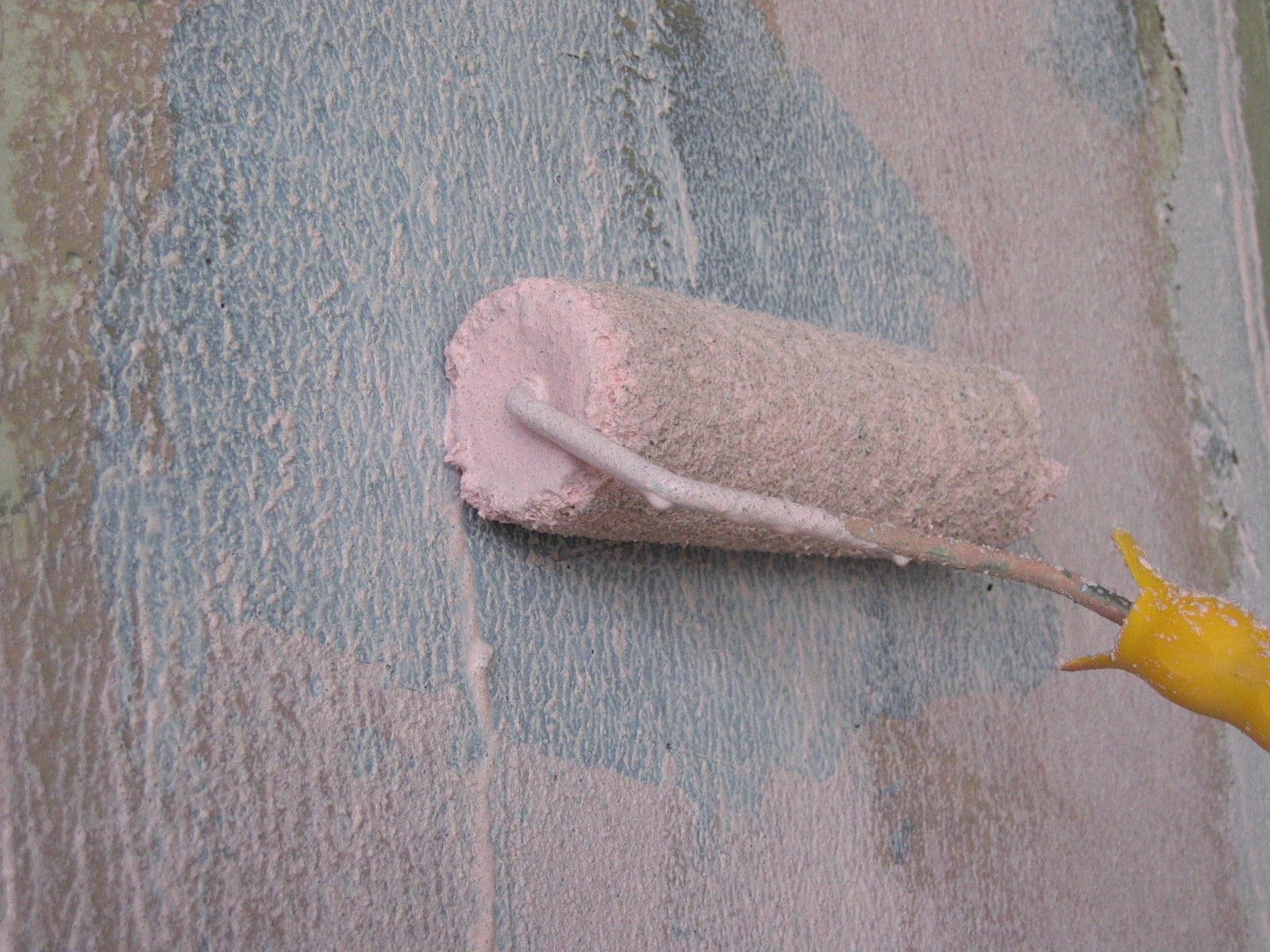
- Strengthens the surface. The soil penetrates into the pores of the base and sticks them together, thereby strengthening the surface. This quality important for loose/porous surfaces;
- Provides even moisture absorption. The primer forms a film on the surface, due to which moisture is absorbed evenly, respectively, decorative plaster dries evenly.
I must say that for a bark beetle, uniform drying has great importance, since the quality of the grout largely depends on this;
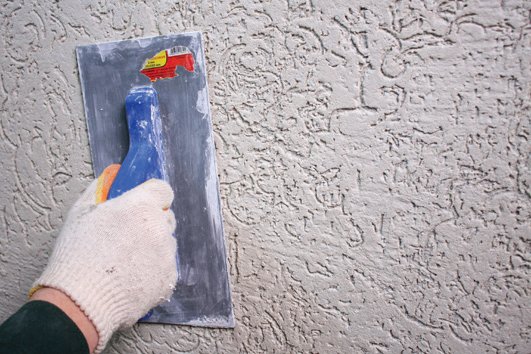
- Has an antiseptic effect. Thanks to this, fungus does not form on the surface treated with soil. This quality is especially important when performing interior work.
From the foregoing it follows that, in principle, you can do without soil. But at the same time, it is impossible to guarantee the quality of the finish and durability. Therefore, in order not to have to spend additional money on building materials and do the work twice, it is better to prime the base.
What primer to use
Currently on sale you can find the following types of primers:

adhesive
The name of this group of primers speaks for itself - they are designed to improve adhesion. Accordingly, adhesive primers should be applied to smooth surfaces such as concrete.
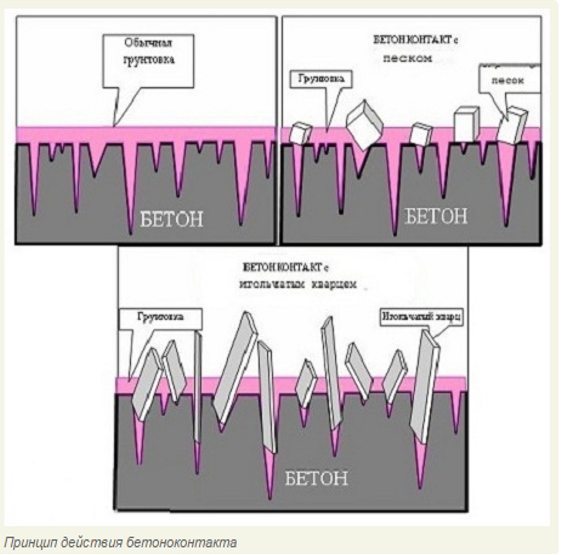
Adhesion is improved due to the presence of a fine abrasive in the composition of the soil. Those. the base after priming becomes rough like sandpaper. Thanks to this, decorative plaster adheres well.
Most often, sand or acicular quartz is used as an abrasive. Those. the soil, in fact, is a water-based binder (adhesive) with a filler in the form of solid mineral particles.

High-quality soil from Knauf - betokontakt
Price:
All prices indicated in this article are current in the spring of 2017.
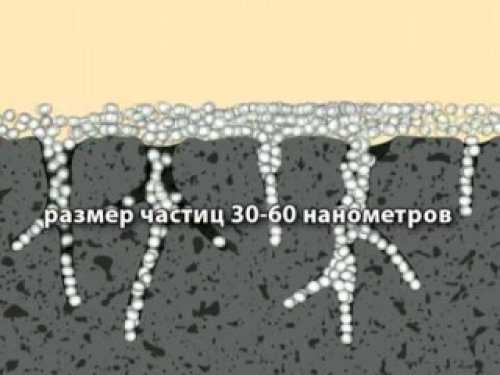
deep penetration
The main property of deep penetration soils is the ability to penetrate deep into the structure of porous surfaces (up to ten centimeters). In this case, the liquid has the property of a binder.
After surface treatment with deep penetration primer, they acquire higher strength. The need for such a composition may be needed if you decide to apply bark beetle, for example, on old plaster, which is dusty and crumbling.
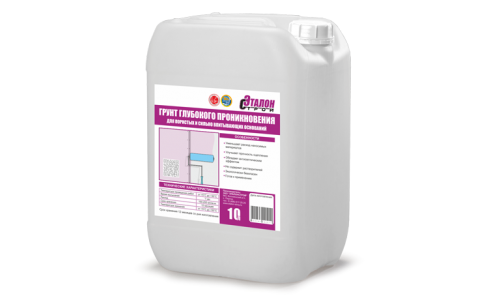
Price:
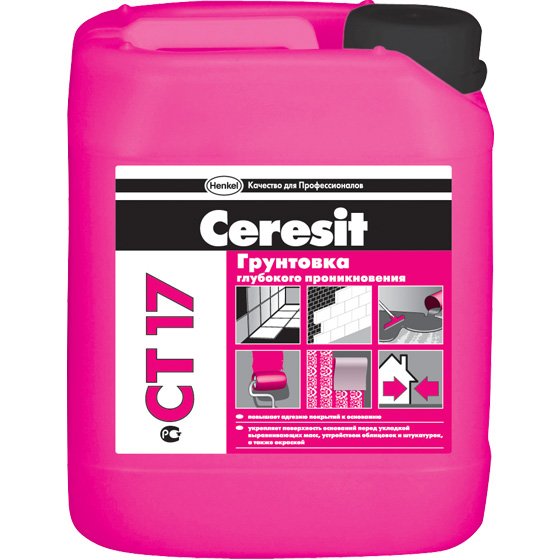
Universal
Universal soils are not in vain called as such - they immediately have all the functions that are listed above:
- Improve adhesion;
- Strengthen the surface
- Create a film for uniform absorption of moisture.
Such compositions are suitable for application to plasters, adhesive compositions used in "wet" facades, etc.
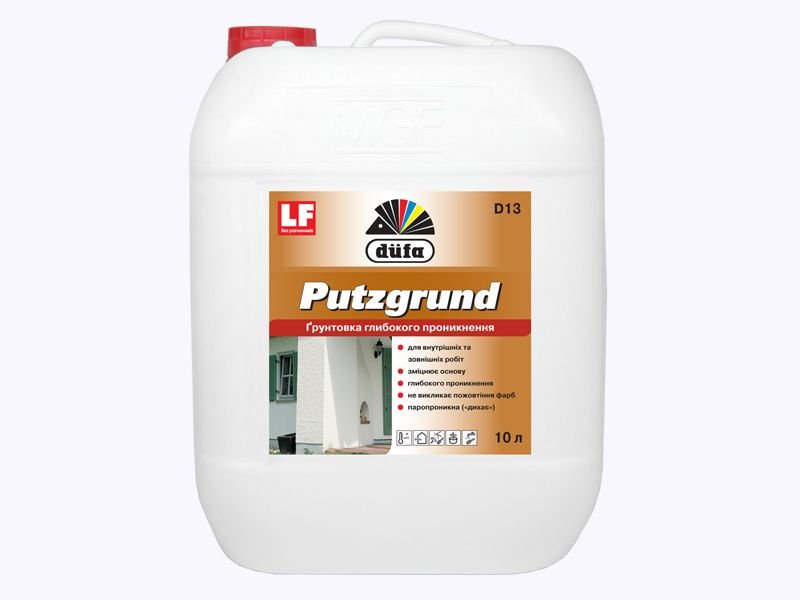
Price:
Primers differ not only in the type of action, but also in the field of application. They are outdoor, for interior work and universal. Compositions for interior work are more environmentally friendly than their facade counterparts.
Application technology
We figured out the choice of soil, now let's look at how a primer is applied under decorative bark beetle plaster. Since the application decorative plaster implies that the walls are already prepared, i.e. cleaned and leveled, we will omit this procedure, and proceed directly to priming.
So, this work is carried out in the following sequence:
| Illustrations | Description of actions |
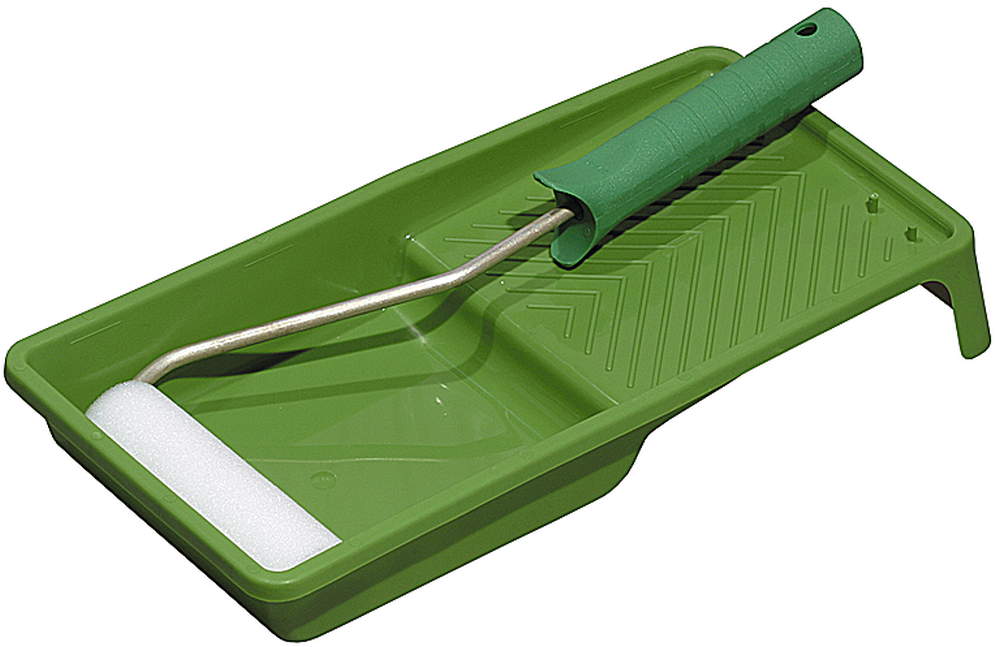 |
Inventory. For priming, you will need the following inventory:
|
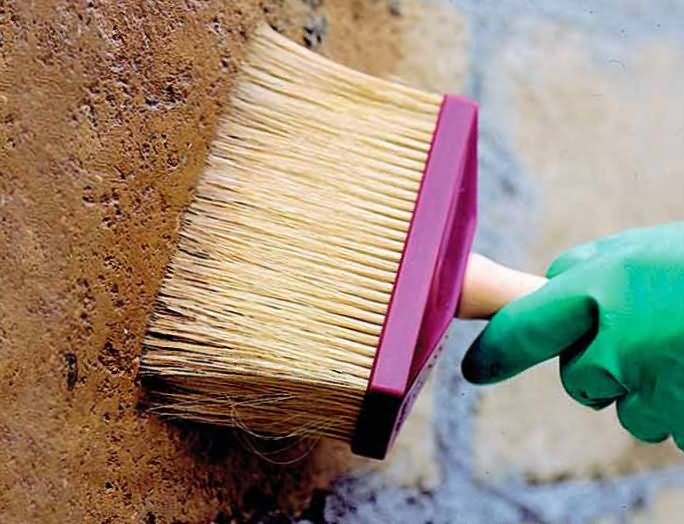 |
Wall preparation. If the surface was previously putty and sanded, then it must be cleaned of dust. To do this, you can use a vacuum cleaner, brush or a damp cloth. |
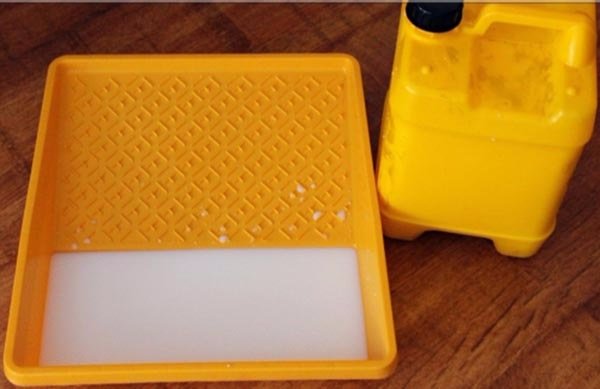 |
Primer preparation:
|
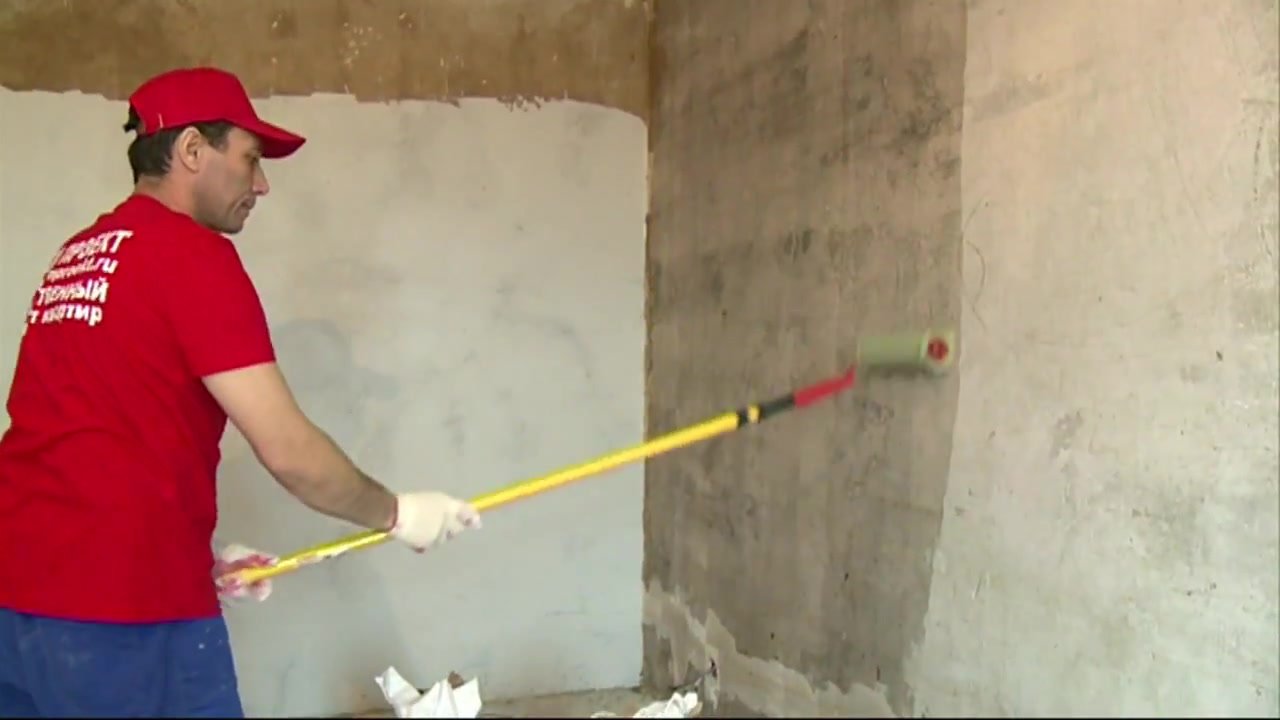 |
Ground application:
Then you can start applying decorative plaster. |
This completes the priming process.
Priming bark beetle
So, we found out why and how to prime the walls before applying the bark beetle. But, this decorative plaster, as you know, needs to be painted after application. From here, beginners often have another question - is it necessary to prime the bark beetle before painting?
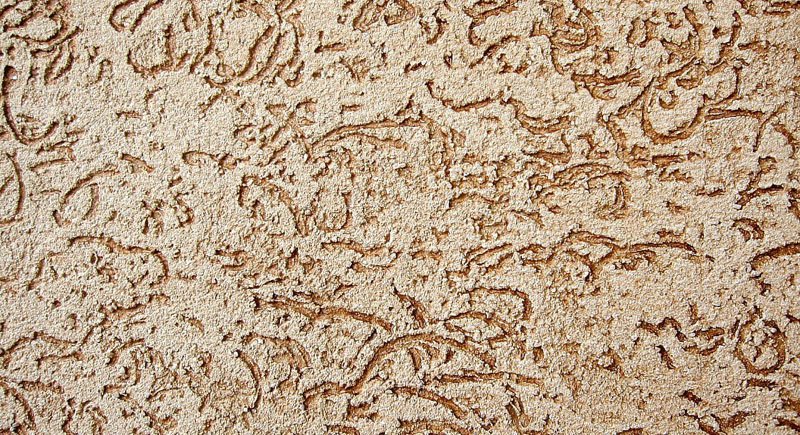
On the one hand, decorative plaster has a rough surface, so the adhesion of the paint and varnish material will be good even without primer. But on the other hand, as a result of a rather porous structure, the paint consumption is large, and the paint is absorbed unevenly, which appears on the surface in the form of spots. Therefore, painting has to be done in several layers.
Since the bark beetle has a relief surface, it is advisable to use a roller with a medium or even long pile for priming and painting it.
To reduce paint consumption and ensure uniform color, the bark beetle is primed before painting. This process is carried out according to the scheme described above without any nuances.
Primer for bark beetle is usually used universal. It is also possible to cover the surface with a deep penetration compound, if, for example, it remains after processing the base.
Bark beetle - this is the name of the type of decorative decoration of the internal or external walls of the building. With the help of an unusual-looking plaster, you can paint any house, any room in an original way.
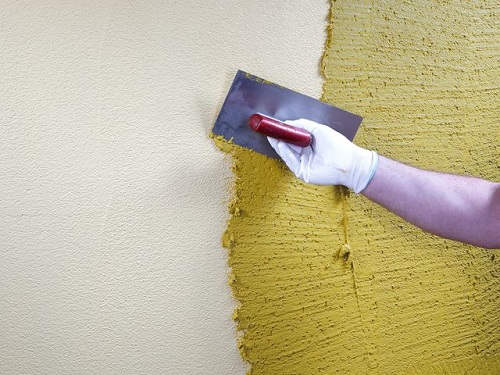 Decorative bark beetle plaster not only decorates the house, but also provides good protection of the walls from external influences.
Decorative bark beetle plaster not only decorates the house, but also provides good protection of the walls from external influences. A feature of the bark beetle is the textured coating. The solution that is applied to the wall contains small granules. In the process of grinding the mixture over the surface, they form characteristic grooves. Outwardly, the surface of the walls is, as it were, eaten by a woodworm.
Exist various technologies decorative finishes using the bark beetle method: rain, carpet, lamb. It all depends on the method of grinding the plaster.
Structural plaster will not only decorate the house, but also provide good protection of the walls from external influences. The prepared surface can then be painted in different colors. Note that there is a way to color the bark beetle by tinting the working mixture. To do this, a special pigment is added to the solution, which will determine the future. Let's find out in what ways the facade structural plaster of the bark beetle is painted?
Coloring of the working mixture
The first way, but not the only one. As mentioned, here the coloring matter is added to the working solution. This will help fill in the texture grooves with paint, which are more difficult to paint over with normal wall painting (when a roller is used).
Add the desired paint to the working plaster solution. Next, the walls are plastered and the mixture is rubbed over the surface according to the finishing technology. After the coating hardens, painting begins. The color scheme of the coloring mixture may be identical to that which was added to the plaster. You can choose lighter, or, conversely, darker shades of color.
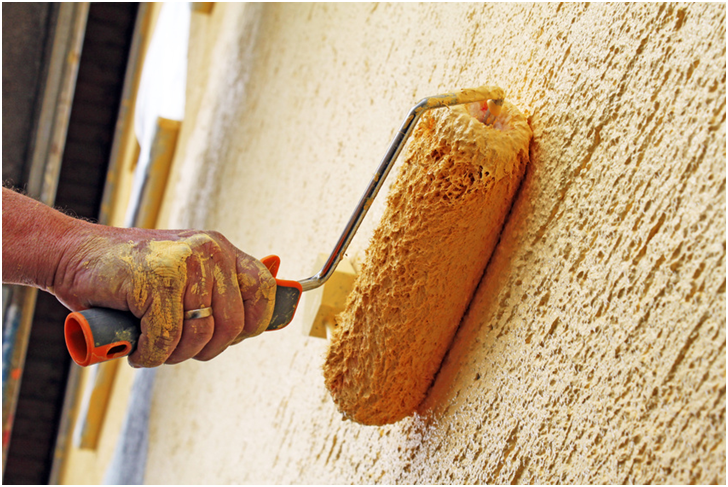 The color of the paint may be identical to the color of the plaster
The color of the paint may be identical to the color of the plaster During staining, the roller should not be strongly pressed against the surface so that excess dye does not flow into the recesses. In this case, the structural feature will stand out better, forming a three-dimensional effect. Note that the consumption of the finish coating in this way will be relatively small.
Intermediate coloring
The second method involves another universal staining method - when paint-primer is used. This means that the pigment is added to the primer mixture. Note that it is recommended to apply a primer in any case. It not only increases the protective properties of decorative finishes, but also provides better adhesion (adhesion) of paint and plaster. The primer paint is more liquid in consistency, which will make it possible to paint over the deepenings of the bark beetle well.
Unfortunately, painting the walls with one painted primer will not end, and the house will not look very attractive. Therefore, a final color is required. Here, just as in the previous finishing method, you can use the same tone of paint or choose a different one that highlights the pattern.
Traditional coloring
Facade decoration with decorative plaster, followed by painting the walls, can also be done in a third way - with special paint of one color or several.
On such plaster you can paint:
- acrylic blends. Usually they are produced on a water basis (dispersions or emulsions), therefore they are environmentally friendly and safe. Suitable for all interior applications. However, there is also a facade acrylic dispersion. Of the obvious advantages, one can single out: moisture resistance and vapor permeability, strength and durability, an extensive palette of colors and shades.
- Alkyd mixtures. They can easily process the house from the outside, since the substance is as resistant to atmospheric influence as possible. But for work inside the house it is undesirable to use it. Organic solvents are present in the solution, which gives a characteristic odor.
- Oil mixtures. For lack of a better solution, at one time oil coloring solutions were very popular, despite their shortcomings. For example, the lack of vapor permeability prevents the walls from "breathing". Due to solvents, they smell and have increased flammability. And they are weakly resistant to alkaline exposure, heat and ultraviolet radiation. Modern, more effective paints and varnishes have practically forced oil suspensions out of the market.
- Note that there is a LKP "bark beetle" for sale, designed for metal. The metal is not plastered here, the characteristic textural effect is created by the coloring solution itself. The original uniform finish is obtained if metal and stone are present in the interior. It seems that decorative coating"transitions" from one material to another. And the metal ceases to be like itself.
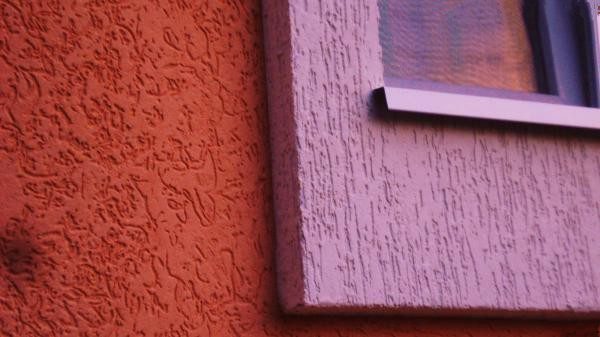 With the help of decorative plaster, you can paint any building in an original way.
With the help of decorative plaster, you can paint any building in an original way. An important point of purchase is to calculate the coverage expense. It is produced according to the following formula: the area of the treated surface is multiplied by the average consumption of the selected product. And then the result is multiplied by the number of applied layers. You can find out what the average consumption is from specifications paint products.
When the right materials purchased, you can take up the work. For work, a roller and a brush are used. Under the roller you need to purchase a bath.
Open the package with the coloring mixture and stir well. If the substance is too viscous, it can be slightly diluted (with water or white spirit). It is recommended not to add more than 10% of the total mass of the suspension, as the paint mixture may lose its properties. Another point about viscosity: thinner mixtures have less consumption.
Pour a small amount of the substance into the bath. We dip the roller, scrolling around the entire circumference and blotting along the ribbed surface of the bath to remove excess. Let's move on to coloring.
It is better to start work from above the wall, so you can avoid drops and streaks on the painted surface. We paint once, take a break until the coating is completely dry, and repeat the coloring.
The technology of staining with the effect of a three-dimensional surface is produced as follows. First, with a brush, carefully paint over the structural recesses. We are waiting for it to dry. Then we apply the final decorative coating. For finishing work, you can choose a contrasting color. We drive the roller without pressure so that the mixture does not flow into the pattern.
When performing outdoor work, be sure to take into account the permissible atmospheric conditions. This applies to both plastering and painting. When the job is done, don't leave the painting tool dirty. Otherwise, it can no longer be used.
With the help of such original materials, you can unusually decorate the whole house, both inside and outside. Properly selected products and compliance with the technological features of the staining process will transform the house for many years.
Many were convinced by personal experience that it is in all respects an excellent and most optimal solution. The construction material for decoration has many undeniable advantages that are appreciated by both builders and consumers. This universal coating can be seen not only on the walls of private houses and public buildings, but also on many other buildings.
Often, decorative plaster applied to the walls is painted with facade paint, which is very resistant to various environmental changes, has a long service life just like the bark beetle, they have a fairly short application period and do not need any special skills from the performers. However, like everything in our world, the coloring of facade decorative plaster has not only its many advantages, but also some disadvantages.
Such painting will allow you to achieve original ideas, give you the opportunity to experiment with a combination of different shades.
A surface treated in this way will provide a high degree of protection for the walls, and they will not be afraid of all kinds of temperature changes, precipitation and other natural phenomena.
The widest range of shades available to choose from to suit your preferences.
Cons of bark beetle coloring
On the one hand, the procedure for painting the facade bark beetle is not particularly complicated, but on the other hand, it takes a lot of time, since the surface of the bark beetle has many depressions and, in general, a rather complex relief, due to which the material does not lie on it perfectly. That is, it is rather difficult to paint such a facade evenly. The best option for this work will be the combined use of a roller with a brush, which can successfully paint hard-to-reach places on the surface. Or you can use a spray gun, it sprays paint on the facade.
Features of painting the rough surface of the facade "Bark beetle"
 Interesting is the painting of the bark beetle in two color shades. A great idea is to paint the plaster in bulk in one color, and then apply a different tone to the finished facade. You can paint over individual areas more carefully to highlight them. This approach will bring you a spectacular and unusual result, which will be highly appreciated not only by you, but also by everyone around you.
Interesting is the painting of the bark beetle in two color shades. A great idea is to paint the plaster in bulk in one color, and then apply a different tone to the finished facade. You can paint over individual areas more carefully to highlight them. This approach will bring you a spectacular and unusual result, which will be highly appreciated not only by you, but also by everyone around you.
Before with decorative plaster, it is desirable to know about some of the features of this work. So, for example, in order to facilitate the staining procedure, it does not hurt to add color to it during the preparation of the bark beetle, which will be used for coloring in the future. Now you can immediately order the paint with the desired shade. It is possible to paint the surface of decorative plaster only after its final drying, which on average is approximately 48 hours.
When painting, it is desirable to have several rollers and brushes of different widths. A non-standard color can be obtained if you use rollers with a short pile. They will help to achieve an unusual attractive ornament on the painted surface. In addition, sponges, soft rubber, mittens can be used to facilitate the coloring process. In order to give the painted surface antiquity, you can paint the protrusions with recesses with gold or silver paint. You can also combine the coloring of smooth and textured areas. With this technology, it is worth starting painting from the textured areas of the surface to be painted.
Facade paint consumption
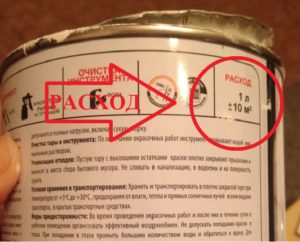 In addition, before starting the process, it is important to know what consumption of facade paint per 1m2 is necessary for this work. To do this, you need to take into account every feature of the surface being chipped, the type of paint and varnish products, the number of planned layers and other nuances that can affect material consumption. For example, the expense different types facade paint - water-based, acrylic, alkyd, oil, etc. - is different. On average, the consumption is in the range of 150 - 300 gm / m2. Look at the consumption of the paint you have chosen on the bank, this information is always indicated by the manufacturer. The minimum consumption of water-based paint, because. it is the least absorbed into the surface. To reduce the consumption of facade paint, apply a layer of primer to the wall, it increases adhesion, closes pores and eliminates dust. The paint lays down on the primed surface more evenly and is less absorbed into the surface.
In addition, before starting the process, it is important to know what consumption of facade paint per 1m2 is necessary for this work. To do this, you need to take into account every feature of the surface being chipped, the type of paint and varnish products, the number of planned layers and other nuances that can affect material consumption. For example, the expense different types facade paint - water-based, acrylic, alkyd, oil, etc. - is different. On average, the consumption is in the range of 150 - 300 gm / m2. Look at the consumption of the paint you have chosen on the bank, this information is always indicated by the manufacturer. The minimum consumption of water-based paint, because. it is the least absorbed into the surface. To reduce the consumption of facade paint, apply a layer of primer to the wall, it increases adhesion, closes pores and eliminates dust. The paint lays down on the primed surface more evenly and is less absorbed into the surface.
From the use of an airbrush, there are only pluses: consumption is reduced, it is easy and quick to apply paint, the surface is evenly painted
For convenience, you should have on hand such accessories as:
- lace for delimiting and distributing paint over the surface;
- several facade brushes and rollers of different widths;
- corrugated containers for holding and squeezing paint in them.
Paint should be applied in at least two coats. You can add a little water to it so that the mixture is not very thick. Further, it is desirable to cover the area adjacent to the structure with a film in order to exclude the possibility of contamination. Many experts recommend additionally applying varnish or protective wax, which will not only increase the service life, but also add saturation and shine to the surface. Paint with a golden or silver tint looks especially aesthetically pleasing, which, in, gives the house maximum expressiveness.
Bark beetle is rightfully considered one of the most popular coatings for interior and exterior work. The fact is that it is quite easy to apply to the surface, and the resulting one is distinguished by its aesthetic originality. But in order to achieve a more significant effect, it is necessary to paint the bark beetle. This is done in various ways, each of which allows you to get the desired result.
A little about plaster
What is so attractive about this plaster? There are a number of undeniable advantages that distinguish this mixture from others:
- A very strong layer is created, which is also distinguished by safety. That is, the composition does not emit harmful substances.
- Minor load on the walls. This is due to the low weight of the material.
- Not afraid of temperature changes and high humidity. It can retain its properties for several decades.
- Does not shrink. Due to this, cracks and other damage to the coating do not form.
- Ease of use. In addition to the fact that professional skills and special tools are not required for application, subsequently, caring for it is not much of a hassle.
- Rich range of colors. In fact, the initial layer of material that allows for the manifestation of fantasy. Namely - use any shades.
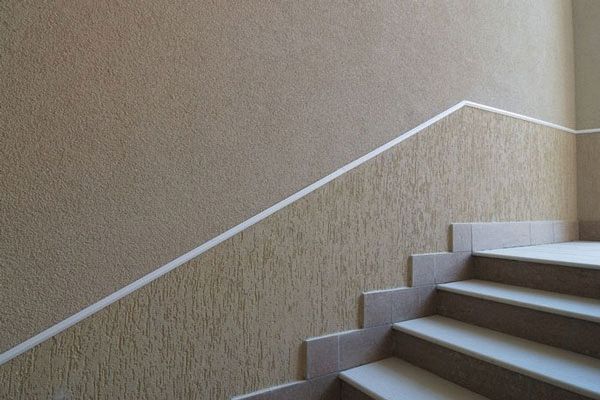
What paint to choose?
It is the last point, which refers to the advantages of bark beetle decorative plaster, that can be considered the most significant when it comes to creating an individual interior.
On a note! It should be understood that a special bark beetle, which is designed specifically for such work, does not exist. Therefore, you need to focus on the available materials.
Preference should be given to the most common options.
oily
This suspension allows you to create a very bright and saturated surface. But there are also numerous disadvantages. Among them are especially distinguished:
- Almost complete lack of vapor permeability.
- Fear of exposure to alkaline substances.
- Slight fire resistance.
In principle, this option is already considered obsolete for this kind of work. Therefore, it is preferable to give preference to more modern compositions.
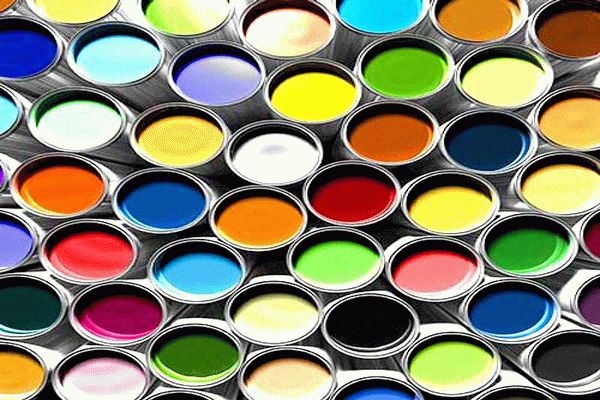
Alkyd
An excellent composition, but it is better to use it for work carried out outdoors. The reason for this is simple: this mixture has a very specific smell, which can be weathered (indoors) for many years. But there are also pluses:
- Low price.
- Neutrality to influence of temperature and humidity.

Acrylic
Many specialists who professionally paint bark beetle plaster prefer this particular suspension. She deserved this attitude for the following reasons:
- Environmental friendliness. The mixture is completely safe.
- The components included in the composition, namely acrylates, make the coating strong and very durable.
- Variety of color shades. There is a lot of room for imagination.
- Vapor permeability. That is, the wall will breathe and the structure of the coating will not be disturbed.
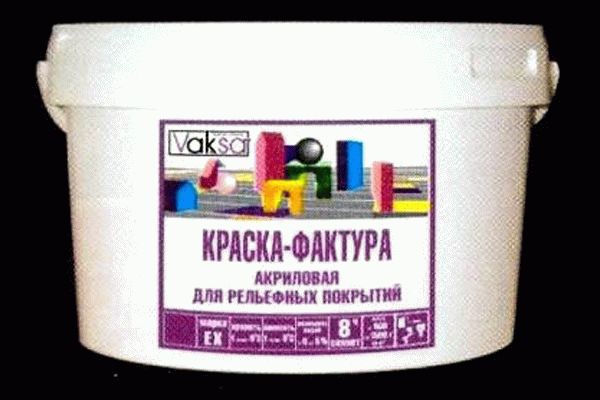
It can be concluded that this material is indeed the optimal solution.
What does staining
Naturally, staining is not the only solution. The color scheme is achieved in other ways: adding color to the mixture, waxing or applying varnish. But it is the paint that has a number of advantages:
- It is possible to get a unique solution for creating an interior. There is an opportunity to create interesting design options. Especially if you apply several shades at once.
- An additional protective layer appears.
- Even a small room can be divided into several zones without using additional materials.
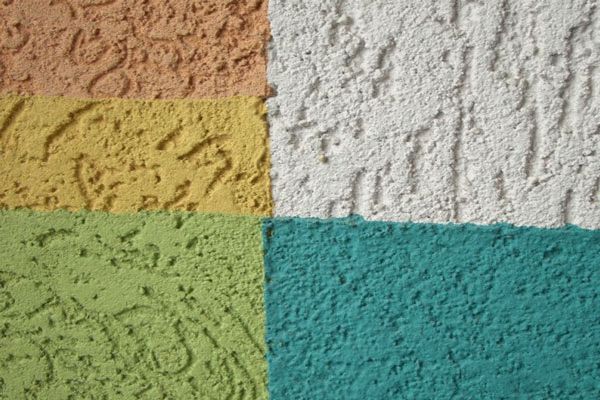
It seems that there can be no shortcomings. It's not entirely true, they exist.
- You have to put in a lot of effort. The fact is that the process itself is very laborious. It will take a lot of time, sometimes even more than the application of the plaster itself. This is due to the complexity of the relief, so the colorful composition is distributed unevenly. You have to work with several tools: a roller, a brush and a sponge.
- If you limit yourself to only one shade, it is difficult to get an interesting result. Although no one forbids applying everything in one uniform layer. But there is a high probability of getting a rather ordinary wall, devoid of any individuality. That is, the texture is simply leveled.
If you carefully compare the pros and cons, it becomes clear that the latter relate to the works themselves, and not to the resulting properties.
What else do you need to know
- To get a surface that will differ in individuality, but reduce labor costs, do the following: the desired color scheme is initially added to the mixture, echoing the color of the paint.
- When choosing a material in a store, pay attention to the manufacturer and the availability of the necessary certificates. It should be understood that the market is flooded with fakes. After applying them to the wall - there are many problems. Sometimes it comes to the fact that you have to completely remove the texture layer.
- You need to wait for the plaster to dry completely. It often happens that you want to finish the work faster. The result of such a rush is stains, swollen and destroyed areas.
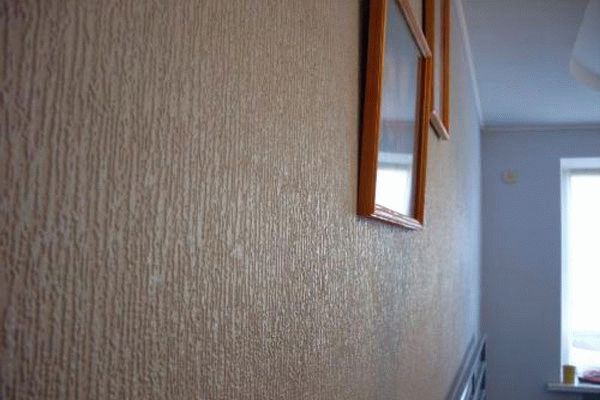
For more convenience, use the following tools:
- Roller with a medium pile (with a short pile - it turns out a great effect, but experience is needed).
- A set of brushes: wide and small.
- Sponge, but better mittens.
On a note! The roller with a long pile perfectly covers the wall, it is possible to immediately process large areas. But a lot of composition accumulates in the recesses, it dries for a very long time and poorly, cracks and swelling appear.
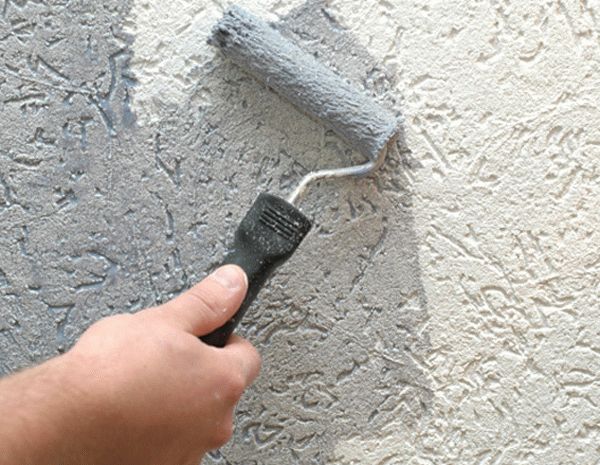
Various color options
To understand how to paint a bark beetle, you should consider several options, each of which is suitable for a specific situation. In principle, all methods are quite similar, they allow you to achieve an excellent effect, but differ in technology. Therefore, it is very important to follow the steps of each process.
The first option is the initial tinting of the mixture
It is considered the simplest option that anyone can implement, even without building skills. But another problem arises - you need to correctly and in the right amount add the selected color to the mixture, and also combine it with subsequent coloring.
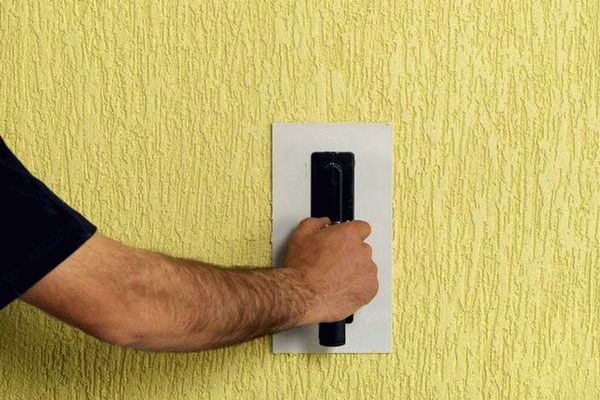
This event looks like this:
- Kohler is applied at the initial stage of mixing decorative plaster. This is done by the amount of the prepared mixture.
- work on applying the composition to the surface.
- Waiting for complete drying. In terms of time - it is better to lay at least two days.
- Now they are coloring.
You can achieve different effects:
- Same color range. To do this, use a light base layer and a darker final one (or vice versa). And also everything can be painted in one color, it will just be much brighter.
- Games of contrasts. This requires the use of a completely different final layer, markedly different from the base.
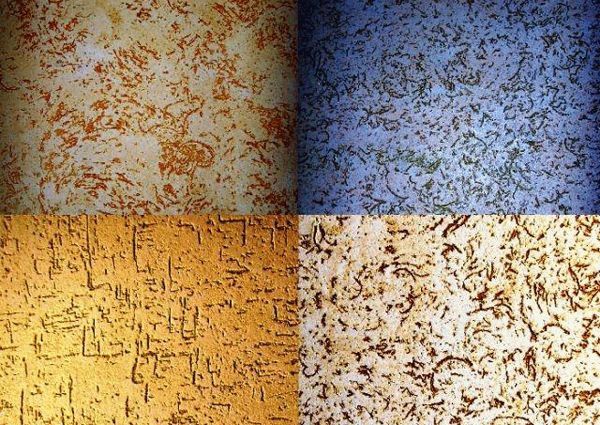
Advice! If possible, then tinting (plasters or paints) is best entrusted to special devices. This service is found in many hardware stores. You can get the best result.
The second option is double coloring
The method described above is really good, but an insufficiently reliable protective layer is obtained. Many grooves remain insufficiently well stained. Therefore, bark beetle painting in two colors is carried out in order to obtain a reliable and very high-quality coating.
The technology is:
- The first layer is applied in a continuous thick layer. It is necessary to ensure that all the recesses are completely filled. Due to the fact that the paint turns out to be quite a lot, it begins to accumulate in the recesses and streaks appear. This is removed by using a sponge to blot the surface.
- Wait until the first layer is completely dry. The time depends on the selected composition and temperature indicators. Now paint a second time. This is done with a small pile roller. They work quickly, covering predominantly convex structures.

The third option is to use a primer
This method is a bit similar to the first and second, but is used in cases where you need to work on an existing bark beetle that has not been tinted. So:
- The selected color pigment is added to the primer solution. It is possible to fill all the pores and create the first colored layer.
- But it turns out a rather unattractive surface. Therefore, a second layer is applied. Of course, the effect will not be so noticeable, but the result will be acceptable.
On a note! Before using the chosen method, it is better to conduct a small experiment first. To do this, paint an inconspicuous area in order to understand what result should be expected.
Coloring decorative plaster Bark beetle is a matter that requires a responsible attitude and labor costs. But this is more than offset by the result.



